Impact of Australian Women's Health Policy: A Detailed Analysis
VerifiedAdded on 2021/01/01
|11
|3579
|256
Report
AI Summary
This report provides a comprehensive analysis of the Australian Women's Health Policy, examining its historical context, objectives, and impact on women's health. The analysis delves into the identified health problems, including chronic diseases, mental health issues, and reproductive health concerns, and the policy's role in addressing them. It explores the common frames of reference and the stakeholders involved, including the target population of women, and how the policy process works. The report also assesses the policy solutions implemented to tackle these health challenges, such as promoting healthy lifestyles and providing access to healthcare services. The evaluation considers evidence-based policy approaches and knowledge translation issues. The analysis highlights the policy's evolution, from the initial 1989 policy to the 2010 update, and its focus on improving the health and well-being of women across Australia. The report emphasizes the importance of stakeholder involvement, including health providers, carers, and various social groups, in the policy's success.

POLICY ANALYSIS
Paraphrase This Document
Need a fresh take? Get an instant paraphrase of this document with our AI Paraphraser
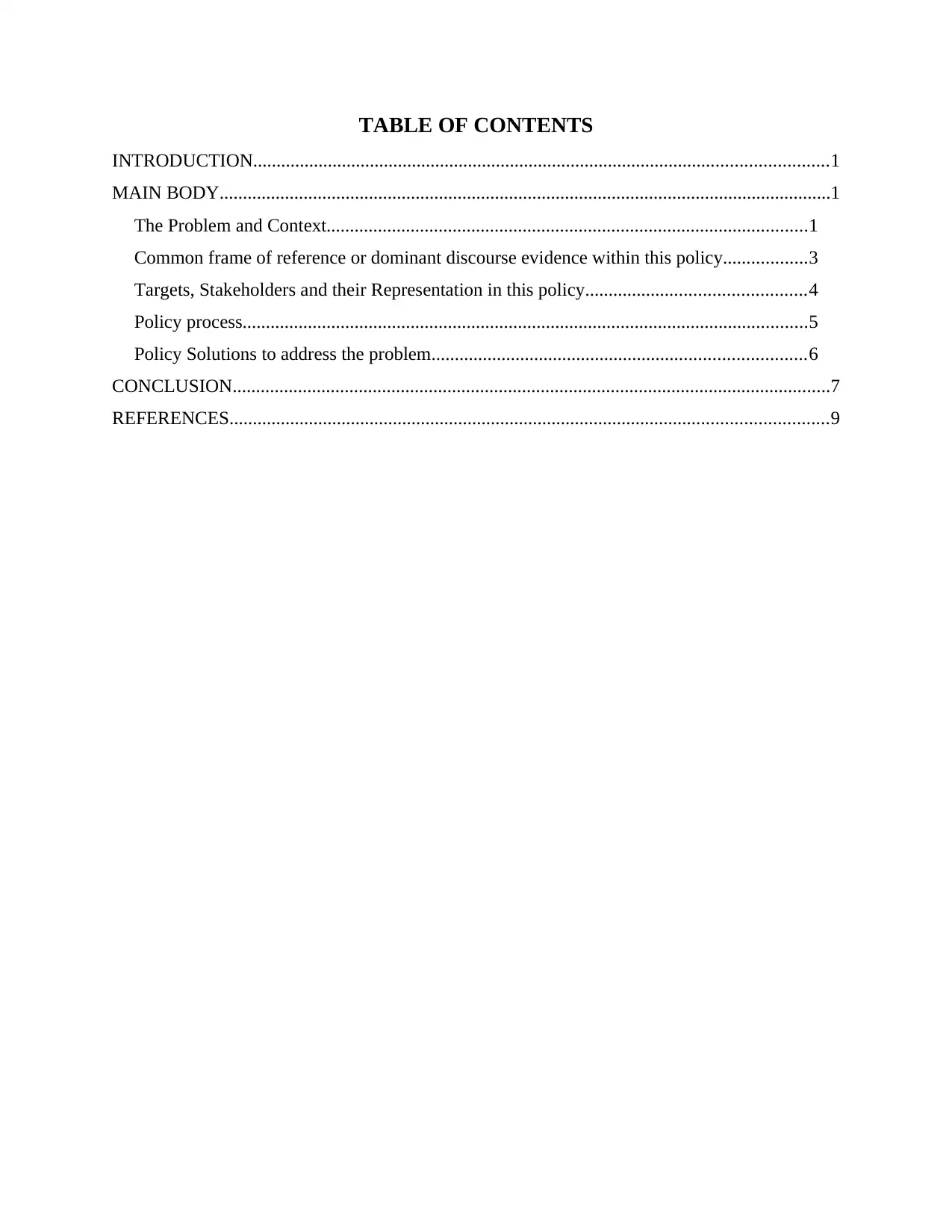
TABLE OF CONTENTS
INTRODUCTION...........................................................................................................................1
MAIN BODY...................................................................................................................................1
The Problem and Context.......................................................................................................1
Common frame of reference or dominant discourse evidence within this policy..................3
Targets, Stakeholders and their Representation in this policy...............................................4
Policy process.........................................................................................................................5
Policy Solutions to address the problem................................................................................6
CONCLUSION................................................................................................................................7
REFERENCES................................................................................................................................9
INTRODUCTION...........................................................................................................................1
MAIN BODY...................................................................................................................................1
The Problem and Context.......................................................................................................1
Common frame of reference or dominant discourse evidence within this policy..................3
Targets, Stakeholders and their Representation in this policy...............................................4
Policy process.........................................................................................................................5
Policy Solutions to address the problem................................................................................6
CONCLUSION................................................................................................................................7
REFERENCES................................................................................................................................9
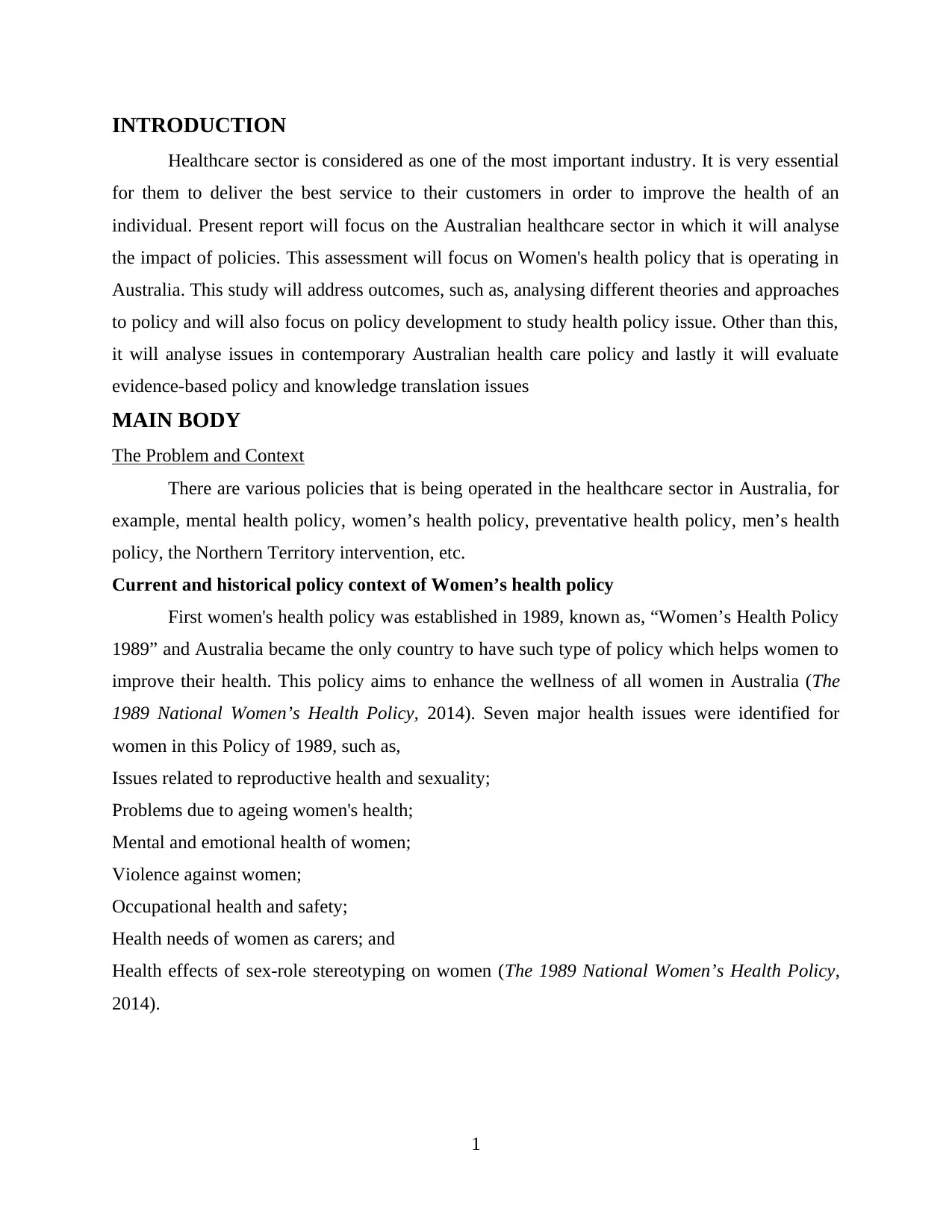
INTRODUCTION
Healthcare sector is considered as one of the most important industry. It is very essential
for them to deliver the best service to their customers in order to improve the health of an
individual. Present report will focus on the Australian healthcare sector in which it will analyse
the impact of policies. This assessment will focus on Women's health policy that is operating in
Australia. This study will address outcomes, such as, analysing different theories and approaches
to policy and will also focus on policy development to study health policy issue. Other than this,
it will analyse issues in contemporary Australian health care policy and lastly it will evaluate
evidence-based policy and knowledge translation issues
MAIN BODY
The Problem and Context
There are various policies that is being operated in the healthcare sector in Australia, for
example, mental health policy, women’s health policy, preventative health policy, men’s health
policy, the Northern Territory intervention, etc.
Current and historical policy context of Women’s health policy
First women's health policy was established in 1989, known as, “Women’s Health Policy
1989” and Australia became the only country to have such type of policy which helps women to
improve their health. This policy aims to enhance the wellness of all women in Australia (The
1989 National Women’s Health Policy, 2014). Seven major health issues were identified for
women in this Policy of 1989, such as,
Issues related to reproductive health and sexuality;
Problems due to ageing women's health;
Mental and emotional health of women;
Violence against women;
Occupational health and safety;
Health needs of women as carers; and
Health effects of sex-role stereotyping on women (The 1989 National Women’s Health Policy,
2014).
1
Healthcare sector is considered as one of the most important industry. It is very essential
for them to deliver the best service to their customers in order to improve the health of an
individual. Present report will focus on the Australian healthcare sector in which it will analyse
the impact of policies. This assessment will focus on Women's health policy that is operating in
Australia. This study will address outcomes, such as, analysing different theories and approaches
to policy and will also focus on policy development to study health policy issue. Other than this,
it will analyse issues in contemporary Australian health care policy and lastly it will evaluate
evidence-based policy and knowledge translation issues
MAIN BODY
The Problem and Context
There are various policies that is being operated in the healthcare sector in Australia, for
example, mental health policy, women’s health policy, preventative health policy, men’s health
policy, the Northern Territory intervention, etc.
Current and historical policy context of Women’s health policy
First women's health policy was established in 1989, known as, “Women’s Health Policy
1989” and Australia became the only country to have such type of policy which helps women to
improve their health. This policy aims to enhance the wellness of all women in Australia (The
1989 National Women’s Health Policy, 2014). Seven major health issues were identified for
women in this Policy of 1989, such as,
Issues related to reproductive health and sexuality;
Problems due to ageing women's health;
Mental and emotional health of women;
Violence against women;
Occupational health and safety;
Health needs of women as carers; and
Health effects of sex-role stereotyping on women (The 1989 National Women’s Health Policy,
2014).
1
⊘ This is a preview!⊘
Do you want full access?
Subscribe today to unlock all pages.

Trusted by 1+ million students worldwide
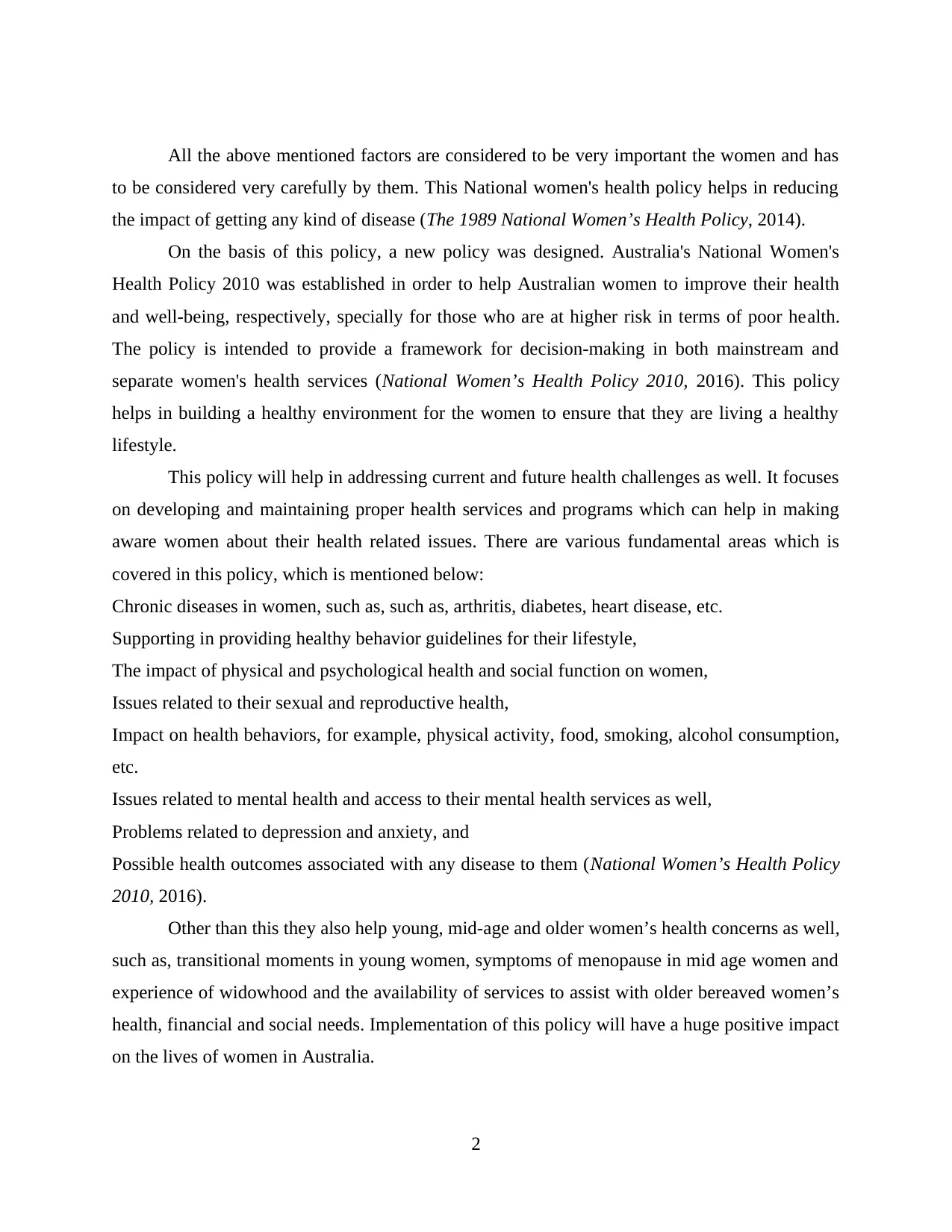
All the above mentioned factors are considered to be very important the women and has
to be considered very carefully by them. This National women's health policy helps in reducing
the impact of getting any kind of disease (The 1989 National Women’s Health Policy, 2014).
On the basis of this policy, a new policy was designed. Australia's National Women's
Health Policy 2010 was established in order to help Australian women to improve their health
and well-being, respectively, specially for those who are at higher risk in terms of poor health.
The policy is intended to provide a framework for decision-making in both mainstream and
separate women's health services (National Women’s Health Policy 2010, 2016). This policy
helps in building a healthy environment for the women to ensure that they are living a healthy
lifestyle.
This policy will help in addressing current and future health challenges as well. It focuses
on developing and maintaining proper health services and programs which can help in making
aware women about their health related issues. There are various fundamental areas which is
covered in this policy, which is mentioned below:
Chronic diseases in women, such as, such as, arthritis, diabetes, heart disease, etc.
Supporting in providing healthy behavior guidelines for their lifestyle,
The impact of physical and psychological health and social function on women,
Issues related to their sexual and reproductive health,
Impact on health behaviors, for example, physical activity, food, smoking, alcohol consumption,
etc.
Issues related to mental health and access to their mental health services as well,
Problems related to depression and anxiety, and
Possible health outcomes associated with any disease to them (National Women’s Health Policy
2010, 2016).
Other than this they also help young, mid-age and older women’s health concerns as well,
such as, transitional moments in young women, symptoms of menopause in mid age women and
experience of widowhood and the availability of services to assist with older bereaved women’s
health, financial and social needs. Implementation of this policy will have a huge positive impact
on the lives of women in Australia.
2
to be considered very carefully by them. This National women's health policy helps in reducing
the impact of getting any kind of disease (The 1989 National Women’s Health Policy, 2014).
On the basis of this policy, a new policy was designed. Australia's National Women's
Health Policy 2010 was established in order to help Australian women to improve their health
and well-being, respectively, specially for those who are at higher risk in terms of poor health.
The policy is intended to provide a framework for decision-making in both mainstream and
separate women's health services (National Women’s Health Policy 2010, 2016). This policy
helps in building a healthy environment for the women to ensure that they are living a healthy
lifestyle.
This policy will help in addressing current and future health challenges as well. It focuses
on developing and maintaining proper health services and programs which can help in making
aware women about their health related issues. There are various fundamental areas which is
covered in this policy, which is mentioned below:
Chronic diseases in women, such as, such as, arthritis, diabetes, heart disease, etc.
Supporting in providing healthy behavior guidelines for their lifestyle,
The impact of physical and psychological health and social function on women,
Issues related to their sexual and reproductive health,
Impact on health behaviors, for example, physical activity, food, smoking, alcohol consumption,
etc.
Issues related to mental health and access to their mental health services as well,
Problems related to depression and anxiety, and
Possible health outcomes associated with any disease to them (National Women’s Health Policy
2010, 2016).
Other than this they also help young, mid-age and older women’s health concerns as well,
such as, transitional moments in young women, symptoms of menopause in mid age women and
experience of widowhood and the availability of services to assist with older bereaved women’s
health, financial and social needs. Implementation of this policy will have a huge positive impact
on the lives of women in Australia.
2
Paraphrase This Document
Need a fresh take? Get an instant paraphrase of this document with our AI Paraphraser
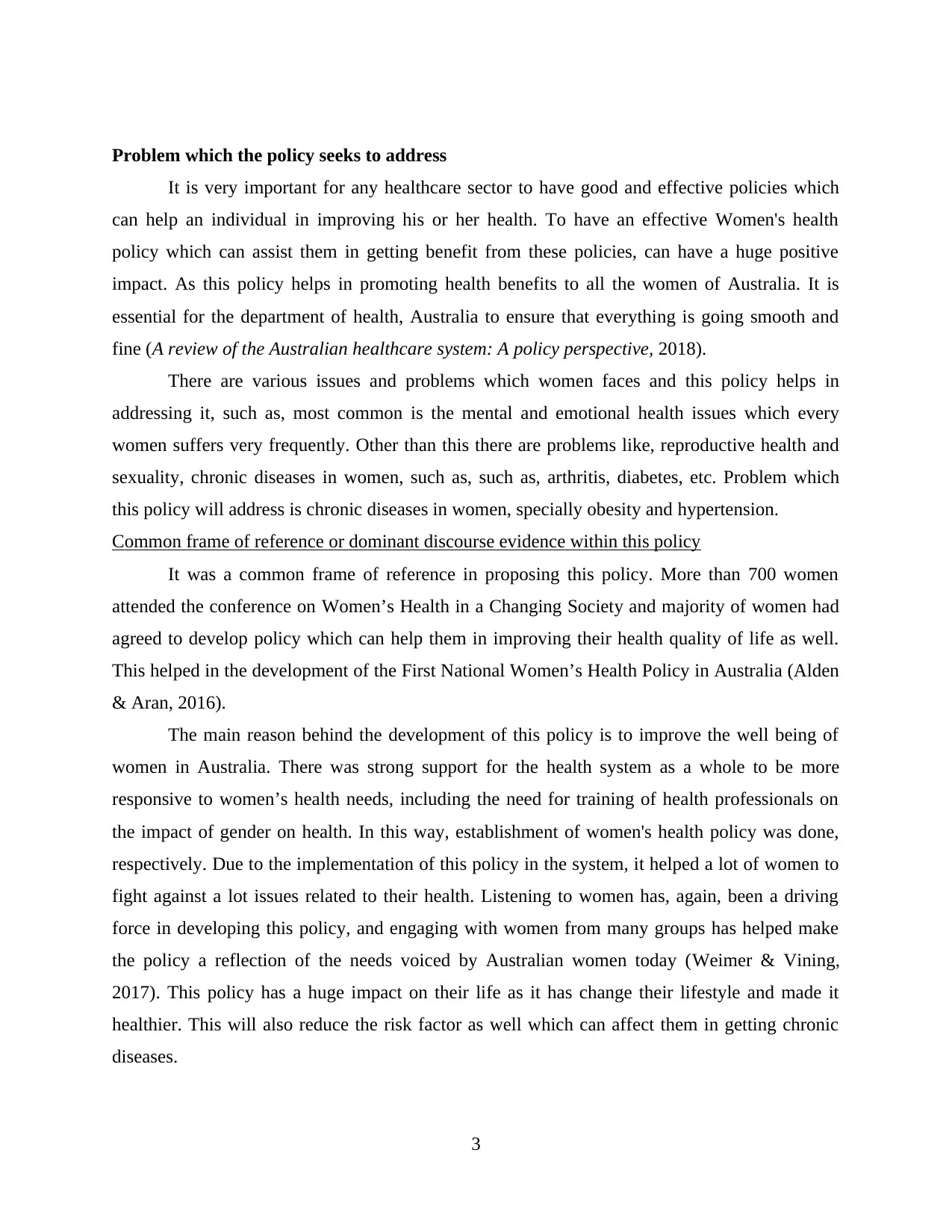
Problem which the policy seeks to address
It is very important for any healthcare sector to have good and effective policies which
can help an individual in improving his or her health. To have an effective Women's health
policy which can assist them in getting benefit from these policies, can have a huge positive
impact. As this policy helps in promoting health benefits to all the women of Australia. It is
essential for the department of health, Australia to ensure that everything is going smooth and
fine (A review of the Australian healthcare system: A policy perspective, 2018).
There are various issues and problems which women faces and this policy helps in
addressing it, such as, most common is the mental and emotional health issues which every
women suffers very frequently. Other than this there are problems like, reproductive health and
sexuality, chronic diseases in women, such as, such as, arthritis, diabetes, etc. Problem which
this policy will address is chronic diseases in women, specially obesity and hypertension.
Common frame of reference or dominant discourse evidence within this policy
It was a common frame of reference in proposing this policy. More than 700 women
attended the conference on Women’s Health in a Changing Society and majority of women had
agreed to develop policy which can help them in improving their health quality of life as well.
This helped in the development of the First National Women’s Health Policy in Australia (Alden
& Aran, 2016).
The main reason behind the development of this policy is to improve the well being of
women in Australia. There was strong support for the health system as a whole to be more
responsive to women’s health needs, including the need for training of health professionals on
the impact of gender on health. In this way, establishment of women's health policy was done,
respectively. Due to the implementation of this policy in the system, it helped a lot of women to
fight against a lot issues related to their health. Listening to women has, again, been a driving
force in developing this policy, and engaging with women from many groups has helped make
the policy a reflection of the needs voiced by Australian women today (Weimer & Vining,
2017). This policy has a huge impact on their life as it has change their lifestyle and made it
healthier. This will also reduce the risk factor as well which can affect them in getting chronic
diseases.
3
It is very important for any healthcare sector to have good and effective policies which
can help an individual in improving his or her health. To have an effective Women's health
policy which can assist them in getting benefit from these policies, can have a huge positive
impact. As this policy helps in promoting health benefits to all the women of Australia. It is
essential for the department of health, Australia to ensure that everything is going smooth and
fine (A review of the Australian healthcare system: A policy perspective, 2018).
There are various issues and problems which women faces and this policy helps in
addressing it, such as, most common is the mental and emotional health issues which every
women suffers very frequently. Other than this there are problems like, reproductive health and
sexuality, chronic diseases in women, such as, such as, arthritis, diabetes, etc. Problem which
this policy will address is chronic diseases in women, specially obesity and hypertension.
Common frame of reference or dominant discourse evidence within this policy
It was a common frame of reference in proposing this policy. More than 700 women
attended the conference on Women’s Health in a Changing Society and majority of women had
agreed to develop policy which can help them in improving their health quality of life as well.
This helped in the development of the First National Women’s Health Policy in Australia (Alden
& Aran, 2016).
The main reason behind the development of this policy is to improve the well being of
women in Australia. There was strong support for the health system as a whole to be more
responsive to women’s health needs, including the need for training of health professionals on
the impact of gender on health. In this way, establishment of women's health policy was done,
respectively. Due to the implementation of this policy in the system, it helped a lot of women to
fight against a lot issues related to their health. Listening to women has, again, been a driving
force in developing this policy, and engaging with women from many groups has helped make
the policy a reflection of the needs voiced by Australian women today (Weimer & Vining,
2017). This policy has a huge impact on their life as it has change their lifestyle and made it
healthier. This will also reduce the risk factor as well which can affect them in getting chronic
diseases.
3
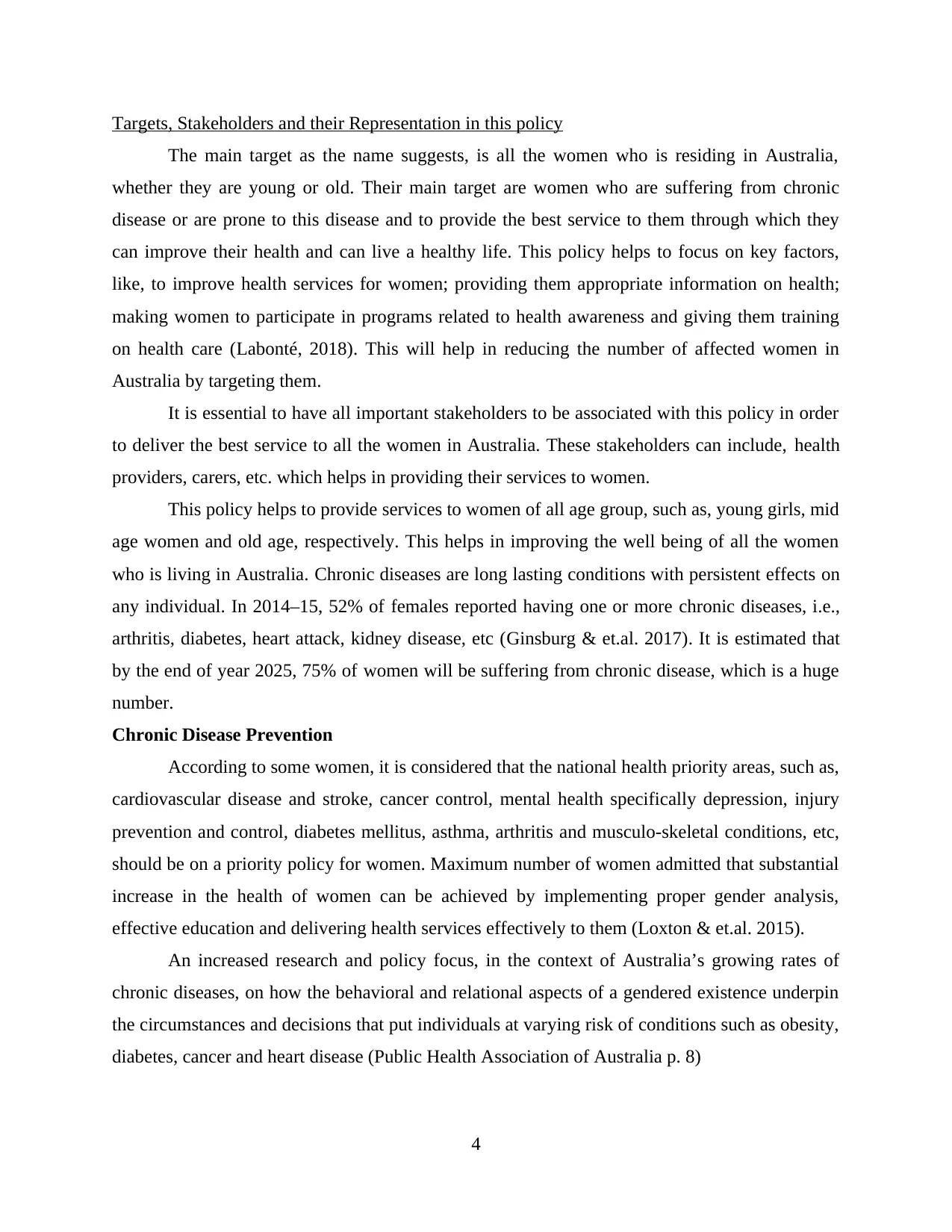
Targets, Stakeholders and their Representation in this policy
The main target as the name suggests, is all the women who is residing in Australia,
whether they are young or old. Their main target are women who are suffering from chronic
disease or are prone to this disease and to provide the best service to them through which they
can improve their health and can live a healthy life. This policy helps to focus on key factors,
like, to improve health services for women; providing them appropriate information on health;
making women to participate in programs related to health awareness and giving them training
on health care (Labonté, 2018). This will help in reducing the number of affected women in
Australia by targeting them.
It is essential to have all important stakeholders to be associated with this policy in order
to deliver the best service to all the women in Australia. These stakeholders can include, health
providers, carers, etc. which helps in providing their services to women.
This policy helps to provide services to women of all age group, such as, young girls, mid
age women and old age, respectively. This helps in improving the well being of all the women
who is living in Australia. Chronic diseases are long lasting conditions with persistent effects on
any individual. In 2014–15, 52% of females reported having one or more chronic diseases, i.e.,
arthritis, diabetes, heart attack, kidney disease, etc (Ginsburg & et.al. 2017). It is estimated that
by the end of year 2025, 75% of women will be suffering from chronic disease, which is a huge
number.
Chronic Disease Prevention
According to some women, it is considered that the national health priority areas, such as,
cardiovascular disease and stroke, cancer control, mental health specifically depression, injury
prevention and control, diabetes mellitus, asthma, arthritis and musculo-skeletal conditions, etc,
should be on a priority policy for women. Maximum number of women admitted that substantial
increase in the health of women can be achieved by implementing proper gender analysis,
effective education and delivering health services effectively to them (Loxton & et.al. 2015).
An increased research and policy focus, in the context of Australia’s growing rates of
chronic diseases, on how the behavioral and relational aspects of a gendered existence underpin
the circumstances and decisions that put individuals at varying risk of conditions such as obesity,
diabetes, cancer and heart disease (Public Health Association of Australia p. 8)
4
The main target as the name suggests, is all the women who is residing in Australia,
whether they are young or old. Their main target are women who are suffering from chronic
disease or are prone to this disease and to provide the best service to them through which they
can improve their health and can live a healthy life. This policy helps to focus on key factors,
like, to improve health services for women; providing them appropriate information on health;
making women to participate in programs related to health awareness and giving them training
on health care (Labonté, 2018). This will help in reducing the number of affected women in
Australia by targeting them.
It is essential to have all important stakeholders to be associated with this policy in order
to deliver the best service to all the women in Australia. These stakeholders can include, health
providers, carers, etc. which helps in providing their services to women.
This policy helps to provide services to women of all age group, such as, young girls, mid
age women and old age, respectively. This helps in improving the well being of all the women
who is living in Australia. Chronic diseases are long lasting conditions with persistent effects on
any individual. In 2014–15, 52% of females reported having one or more chronic diseases, i.e.,
arthritis, diabetes, heart attack, kidney disease, etc (Ginsburg & et.al. 2017). It is estimated that
by the end of year 2025, 75% of women will be suffering from chronic disease, which is a huge
number.
Chronic Disease Prevention
According to some women, it is considered that the national health priority areas, such as,
cardiovascular disease and stroke, cancer control, mental health specifically depression, injury
prevention and control, diabetes mellitus, asthma, arthritis and musculo-skeletal conditions, etc,
should be on a priority policy for women. Maximum number of women admitted that substantial
increase in the health of women can be achieved by implementing proper gender analysis,
effective education and delivering health services effectively to them (Loxton & et.al. 2015).
An increased research and policy focus, in the context of Australia’s growing rates of
chronic diseases, on how the behavioral and relational aspects of a gendered existence underpin
the circumstances and decisions that put individuals at varying risk of conditions such as obesity,
diabetes, cancer and heart disease (Public Health Association of Australia p. 8)
4
⊘ This is a preview!⊘
Do you want full access?
Subscribe today to unlock all pages.

Trusted by 1+ million students worldwide
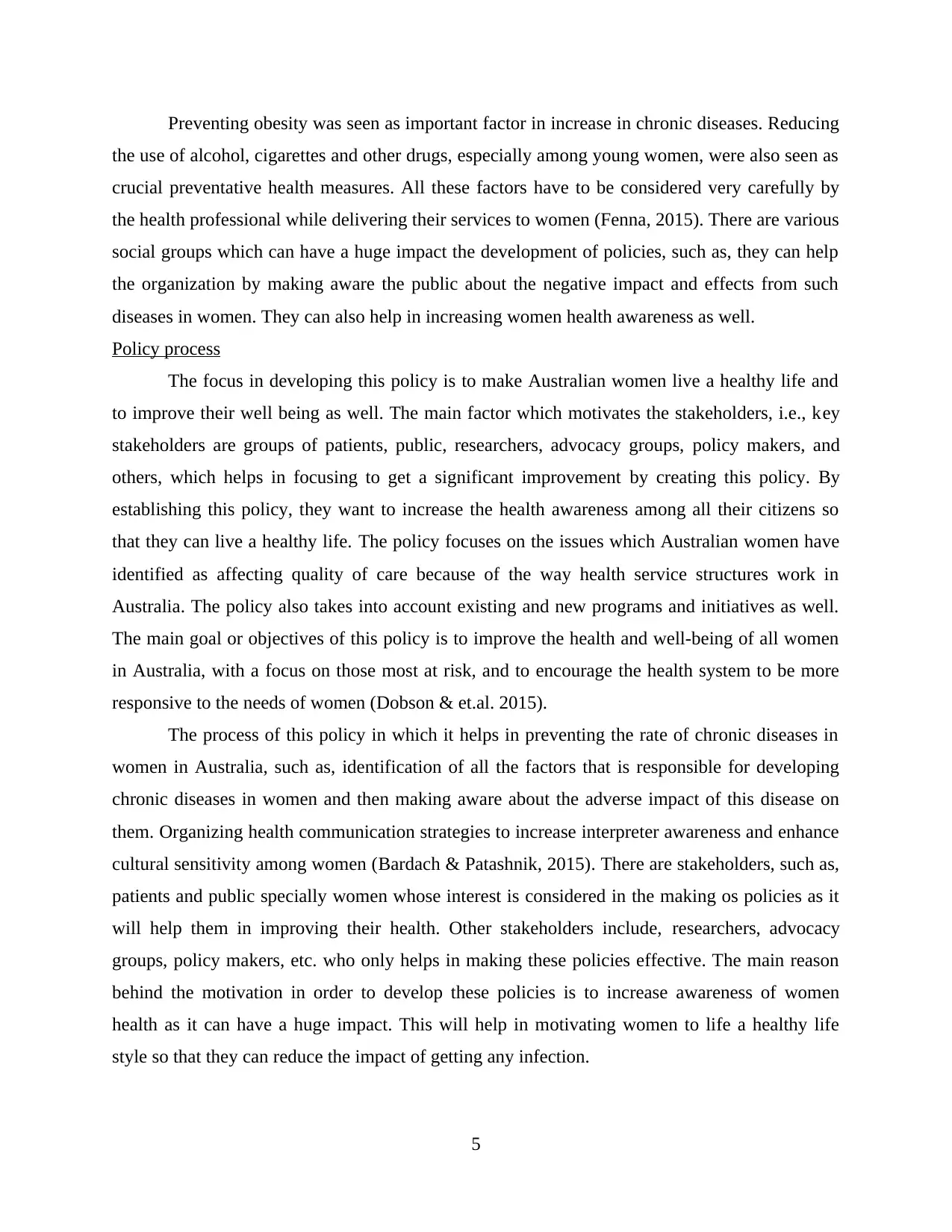
Preventing obesity was seen as important factor in increase in chronic diseases. Reducing
the use of alcohol, cigarettes and other drugs, especially among young women, were also seen as
crucial preventative health measures. All these factors have to be considered very carefully by
the health professional while delivering their services to women (Fenna, 2015). There are various
social groups which can have a huge impact the development of policies, such as, they can help
the organization by making aware the public about the negative impact and effects from such
diseases in women. They can also help in increasing women health awareness as well.
Policy process
The focus in developing this policy is to make Australian women live a healthy life and
to improve their well being as well. The main factor which motivates the stakeholders, i.e., key
stakeholders are groups of patients, public, researchers, advocacy groups, policy makers, and
others, which helps in focusing to get a significant improvement by creating this policy. By
establishing this policy, they want to increase the health awareness among all their citizens so
that they can live a healthy life. The policy focuses on the issues which Australian women have
identified as affecting quality of care because of the way health service structures work in
Australia. The policy also takes into account existing and new programs and initiatives as well.
The main goal or objectives of this policy is to improve the health and well-being of all women
in Australia, with a focus on those most at risk, and to encourage the health system to be more
responsive to the needs of women (Dobson & et.al. 2015).
The process of this policy in which it helps in preventing the rate of chronic diseases in
women in Australia, such as, identification of all the factors that is responsible for developing
chronic diseases in women and then making aware about the adverse impact of this disease on
them. Organizing health communication strategies to increase interpreter awareness and enhance
cultural sensitivity among women (Bardach & Patashnik, 2015). There are stakeholders, such as,
patients and public specially women whose interest is considered in the making os policies as it
will help them in improving their health. Other stakeholders include, researchers, advocacy
groups, policy makers, etc. who only helps in making these policies effective. The main reason
behind the motivation in order to develop these policies is to increase awareness of women
health as it can have a huge impact. This will help in motivating women to life a healthy life
style so that they can reduce the impact of getting any infection.
5
the use of alcohol, cigarettes and other drugs, especially among young women, were also seen as
crucial preventative health measures. All these factors have to be considered very carefully by
the health professional while delivering their services to women (Fenna, 2015). There are various
social groups which can have a huge impact the development of policies, such as, they can help
the organization by making aware the public about the negative impact and effects from such
diseases in women. They can also help in increasing women health awareness as well.
Policy process
The focus in developing this policy is to make Australian women live a healthy life and
to improve their well being as well. The main factor which motivates the stakeholders, i.e., key
stakeholders are groups of patients, public, researchers, advocacy groups, policy makers, and
others, which helps in focusing to get a significant improvement by creating this policy. By
establishing this policy, they want to increase the health awareness among all their citizens so
that they can live a healthy life. The policy focuses on the issues which Australian women have
identified as affecting quality of care because of the way health service structures work in
Australia. The policy also takes into account existing and new programs and initiatives as well.
The main goal or objectives of this policy is to improve the health and well-being of all women
in Australia, with a focus on those most at risk, and to encourage the health system to be more
responsive to the needs of women (Dobson & et.al. 2015).
The process of this policy in which it helps in preventing the rate of chronic diseases in
women in Australia, such as, identification of all the factors that is responsible for developing
chronic diseases in women and then making aware about the adverse impact of this disease on
them. Organizing health communication strategies to increase interpreter awareness and enhance
cultural sensitivity among women (Bardach & Patashnik, 2015). There are stakeholders, such as,
patients and public specially women whose interest is considered in the making os policies as it
will help them in improving their health. Other stakeholders include, researchers, advocacy
groups, policy makers, etc. who only helps in making these policies effective. The main reason
behind the motivation in order to develop these policies is to increase awareness of women
health as it can have a huge impact. This will help in motivating women to life a healthy life
style so that they can reduce the impact of getting any infection.
5
Paraphrase This Document
Need a fresh take? Get an instant paraphrase of this document with our AI Paraphraser
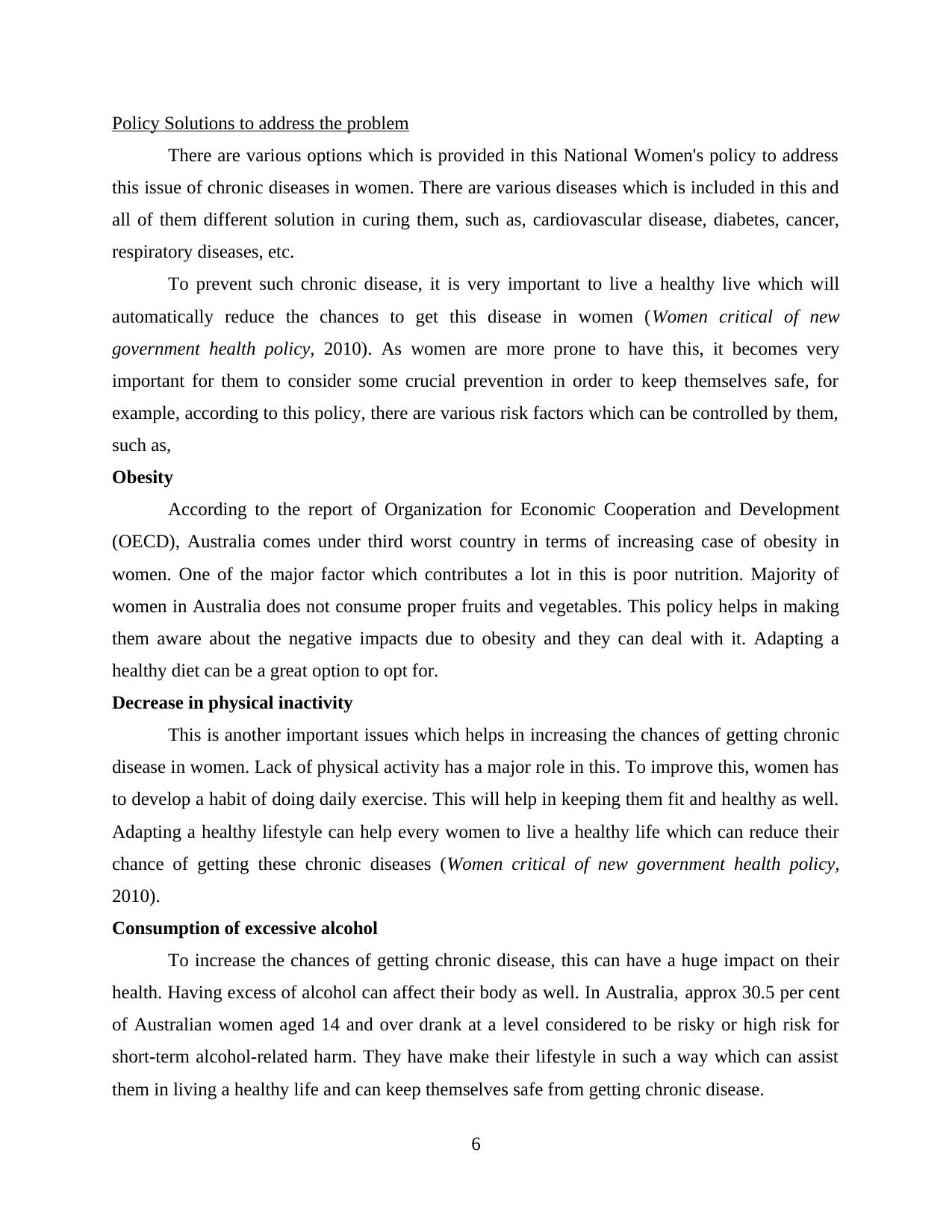
Policy Solutions to address the problem
There are various options which is provided in this National Women's policy to address
this issue of chronic diseases in women. There are various diseases which is included in this and
all of them different solution in curing them, such as, cardiovascular disease, diabetes, cancer,
respiratory diseases, etc.
To prevent such chronic disease, it is very important to live a healthy live which will
automatically reduce the chances to get this disease in women (Women critical of new
government health policy, 2010). As women are more prone to have this, it becomes very
important for them to consider some crucial prevention in order to keep themselves safe, for
example, according to this policy, there are various risk factors which can be controlled by them,
such as,
Obesity
According to the report of Organization for Economic Cooperation and Development
(OECD), Australia comes under third worst country in terms of increasing case of obesity in
women. One of the major factor which contributes a lot in this is poor nutrition. Majority of
women in Australia does not consume proper fruits and vegetables. This policy helps in making
them aware about the negative impacts due to obesity and they can deal with it. Adapting a
healthy diet can be a great option to opt for.
Decrease in physical inactivity
This is another important issues which helps in increasing the chances of getting chronic
disease in women. Lack of physical activity has a major role in this. To improve this, women has
to develop a habit of doing daily exercise. This will help in keeping them fit and healthy as well.
Adapting a healthy lifestyle can help every women to live a healthy life which can reduce their
chance of getting these chronic diseases (Women critical of new government health policy,
2010).
Consumption of excessive alcohol
To increase the chances of getting chronic disease, this can have a huge impact on their
health. Having excess of alcohol can affect their body as well. In Australia, approx 30.5 per cent
of Australian women aged 14 and over drank at a level considered to be risky or high risk for
short-term alcohol-related harm. They have make their lifestyle in such a way which can assist
them in living a healthy life and can keep themselves safe from getting chronic disease.
6
There are various options which is provided in this National Women's policy to address
this issue of chronic diseases in women. There are various diseases which is included in this and
all of them different solution in curing them, such as, cardiovascular disease, diabetes, cancer,
respiratory diseases, etc.
To prevent such chronic disease, it is very important to live a healthy live which will
automatically reduce the chances to get this disease in women (Women critical of new
government health policy, 2010). As women are more prone to have this, it becomes very
important for them to consider some crucial prevention in order to keep themselves safe, for
example, according to this policy, there are various risk factors which can be controlled by them,
such as,
Obesity
According to the report of Organization for Economic Cooperation and Development
(OECD), Australia comes under third worst country in terms of increasing case of obesity in
women. One of the major factor which contributes a lot in this is poor nutrition. Majority of
women in Australia does not consume proper fruits and vegetables. This policy helps in making
them aware about the negative impacts due to obesity and they can deal with it. Adapting a
healthy diet can be a great option to opt for.
Decrease in physical inactivity
This is another important issues which helps in increasing the chances of getting chronic
disease in women. Lack of physical activity has a major role in this. To improve this, women has
to develop a habit of doing daily exercise. This will help in keeping them fit and healthy as well.
Adapting a healthy lifestyle can help every women to live a healthy life which can reduce their
chance of getting these chronic diseases (Women critical of new government health policy,
2010).
Consumption of excessive alcohol
To increase the chances of getting chronic disease, this can have a huge impact on their
health. Having excess of alcohol can affect their body as well. In Australia, approx 30.5 per cent
of Australian women aged 14 and over drank at a level considered to be risky or high risk for
short-term alcohol-related harm. They have make their lifestyle in such a way which can assist
them in living a healthy life and can keep themselves safe from getting chronic disease.
6
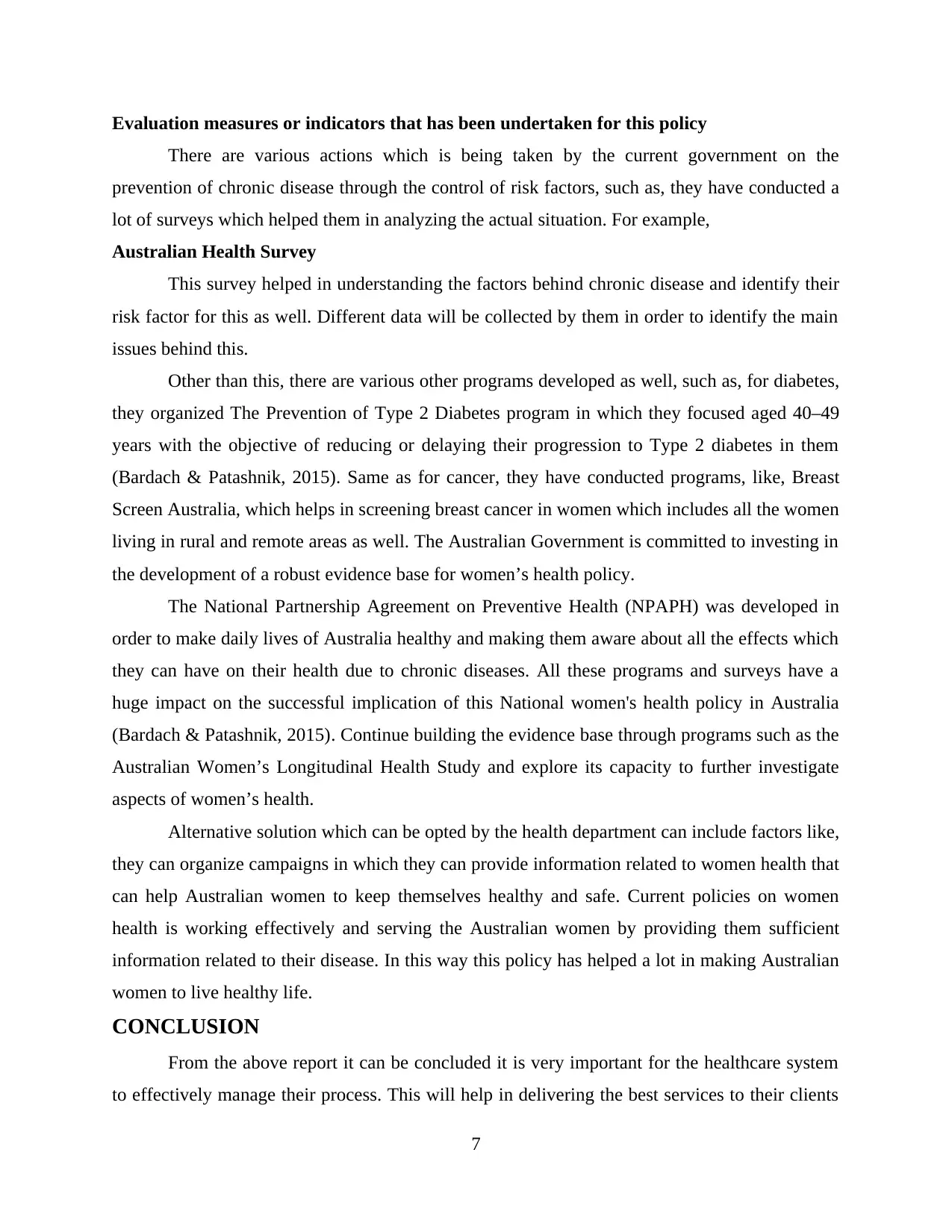
Evaluation measures or indicators that has been undertaken for this policy
There are various actions which is being taken by the current government on the
prevention of chronic disease through the control of risk factors, such as, they have conducted a
lot of surveys which helped them in analyzing the actual situation. For example,
Australian Health Survey
This survey helped in understanding the factors behind chronic disease and identify their
risk factor for this as well. Different data will be collected by them in order to identify the main
issues behind this.
Other than this, there are various other programs developed as well, such as, for diabetes,
they organized The Prevention of Type 2 Diabetes program in which they focused aged 40–49
years with the objective of reducing or delaying their progression to Type 2 diabetes in them
(Bardach & Patashnik, 2015). Same as for cancer, they have conducted programs, like, Breast
Screen Australia, which helps in screening breast cancer in women which includes all the women
living in rural and remote areas as well. The Australian Government is committed to investing in
the development of a robust evidence base for women’s health policy.
The National Partnership Agreement on Preventive Health (NPAPH) was developed in
order to make daily lives of Australia healthy and making them aware about all the effects which
they can have on their health due to chronic diseases. All these programs and surveys have a
huge impact on the successful implication of this National women's health policy in Australia
(Bardach & Patashnik, 2015). Continue building the evidence base through programs such as the
Australian Women’s Longitudinal Health Study and explore its capacity to further investigate
aspects of women’s health.
Alternative solution which can be opted by the health department can include factors like,
they can organize campaigns in which they can provide information related to women health that
can help Australian women to keep themselves healthy and safe. Current policies on women
health is working effectively and serving the Australian women by providing them sufficient
information related to their disease. In this way this policy has helped a lot in making Australian
women to live healthy life.
CONCLUSION
From the above report it can be concluded it is very important for the healthcare system
to effectively manage their process. This will help in delivering the best services to their clients
7
There are various actions which is being taken by the current government on the
prevention of chronic disease through the control of risk factors, such as, they have conducted a
lot of surveys which helped them in analyzing the actual situation. For example,
Australian Health Survey
This survey helped in understanding the factors behind chronic disease and identify their
risk factor for this as well. Different data will be collected by them in order to identify the main
issues behind this.
Other than this, there are various other programs developed as well, such as, for diabetes,
they organized The Prevention of Type 2 Diabetes program in which they focused aged 40–49
years with the objective of reducing or delaying their progression to Type 2 diabetes in them
(Bardach & Patashnik, 2015). Same as for cancer, they have conducted programs, like, Breast
Screen Australia, which helps in screening breast cancer in women which includes all the women
living in rural and remote areas as well. The Australian Government is committed to investing in
the development of a robust evidence base for women’s health policy.
The National Partnership Agreement on Preventive Health (NPAPH) was developed in
order to make daily lives of Australia healthy and making them aware about all the effects which
they can have on their health due to chronic diseases. All these programs and surveys have a
huge impact on the successful implication of this National women's health policy in Australia
(Bardach & Patashnik, 2015). Continue building the evidence base through programs such as the
Australian Women’s Longitudinal Health Study and explore its capacity to further investigate
aspects of women’s health.
Alternative solution which can be opted by the health department can include factors like,
they can organize campaigns in which they can provide information related to women health that
can help Australian women to keep themselves healthy and safe. Current policies on women
health is working effectively and serving the Australian women by providing them sufficient
information related to their disease. In this way this policy has helped a lot in making Australian
women to live healthy life.
CONCLUSION
From the above report it can be concluded it is very important for the healthcare system
to effectively manage their process. This will help in delivering the best services to their clients
7
⊘ This is a preview!⊘
Do you want full access?
Subscribe today to unlock all pages.

Trusted by 1+ million students worldwide
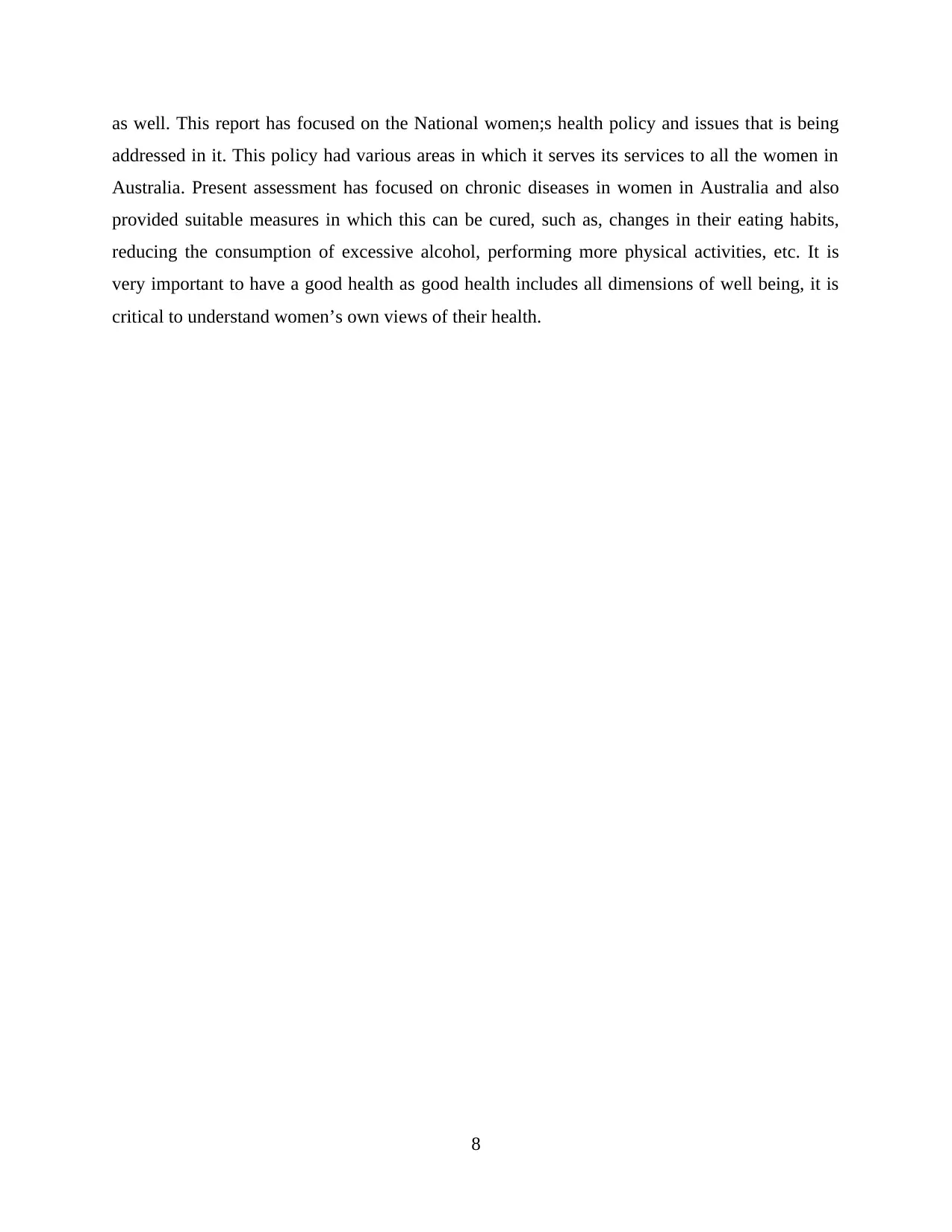
as well. This report has focused on the National women;s health policy and issues that is being
addressed in it. This policy had various areas in which it serves its services to all the women in
Australia. Present assessment has focused on chronic diseases in women in Australia and also
provided suitable measures in which this can be cured, such as, changes in their eating habits,
reducing the consumption of excessive alcohol, performing more physical activities, etc. It is
very important to have a good health as good health includes all dimensions of well being, it is
critical to understand women’s own views of their health.
8
addressed in it. This policy had various areas in which it serves its services to all the women in
Australia. Present assessment has focused on chronic diseases in women in Australia and also
provided suitable measures in which this can be cured, such as, changes in their eating habits,
reducing the consumption of excessive alcohol, performing more physical activities, etc. It is
very important to have a good health as good health includes all dimensions of well being, it is
critical to understand women’s own views of their health.
8
Paraphrase This Document
Need a fresh take? Get an instant paraphrase of this document with our AI Paraphraser
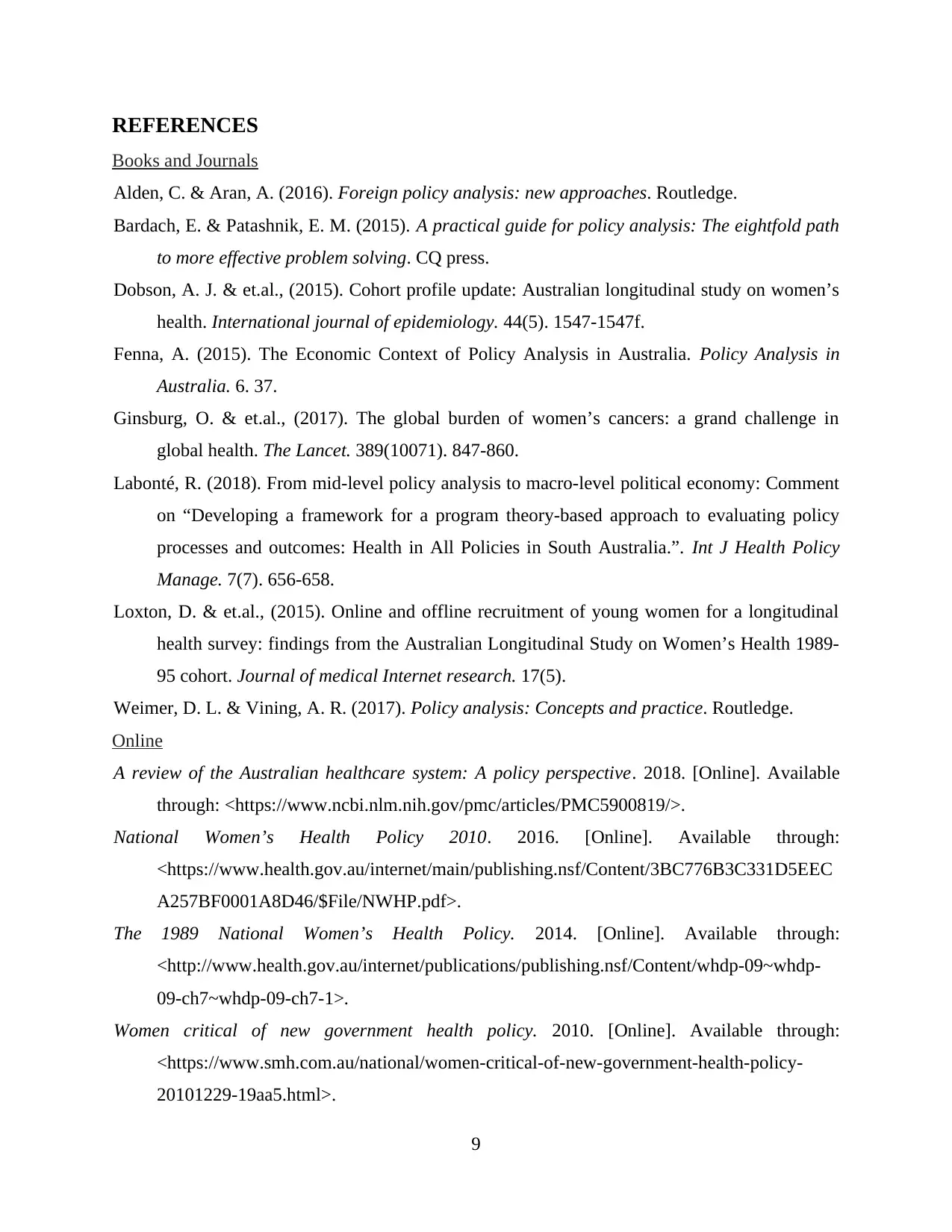
REFERENCES
Books and Journals
Alden, C. & Aran, A. (2016). Foreign policy analysis: new approaches. Routledge.
Bardach, E. & Patashnik, E. M. (2015). A practical guide for policy analysis: The eightfold path
to more effective problem solving. CQ press.
Dobson, A. J. & et.al., (2015). Cohort profile update: Australian longitudinal study on women’s
health. International journal of epidemiology. 44(5). 1547-1547f.
Fenna, A. (2015). The Economic Context of Policy Analysis in Australia. Policy Analysis in
Australia. 6. 37.
Ginsburg, O. & et.al., (2017). The global burden of women’s cancers: a grand challenge in
global health. The Lancet. 389(10071). 847-860.
Labonté, R. (2018). From mid-level policy analysis to macro-level political economy: Comment
on “Developing a framework for a program theory-based approach to evaluating policy
processes and outcomes: Health in All Policies in South Australia.”. Int J Health Policy
Manage. 7(7). 656-658.
Loxton, D. & et.al., (2015). Online and offline recruitment of young women for a longitudinal
health survey: findings from the Australian Longitudinal Study on Women’s Health 1989-
95 cohort. Journal of medical Internet research. 17(5).
Weimer, D. L. & Vining, A. R. (2017). Policy analysis: Concepts and practice. Routledge.
Online
A review of the Australian healthcare system: A policy perspective. 2018. [Online]. Available
through: <https://www.ncbi.nlm.nih.gov/pmc/articles/PMC5900819/>.
National Women’s Health Policy 2010. 2016. [Online]. Available through:
<https://www.health.gov.au/internet/main/publishing.nsf/Content/3BC776B3C331D5EEC
A257BF0001A8D46/$File/NWHP.pdf>.
The 1989 National Women’s Health Policy. 2014. [Online]. Available through:
<http://www.health.gov.au/internet/publications/publishing.nsf/Content/whdp-09~whdp-
09-ch7~whdp-09-ch7-1>.
Women critical of new government health policy. 2010. [Online]. Available through:
<https://www.smh.com.au/national/women-critical-of-new-government-health-policy-
20101229-19aa5.html>.
9
Books and Journals
Alden, C. & Aran, A. (2016). Foreign policy analysis: new approaches. Routledge.
Bardach, E. & Patashnik, E. M. (2015). A practical guide for policy analysis: The eightfold path
to more effective problem solving. CQ press.
Dobson, A. J. & et.al., (2015). Cohort profile update: Australian longitudinal study on women’s
health. International journal of epidemiology. 44(5). 1547-1547f.
Fenna, A. (2015). The Economic Context of Policy Analysis in Australia. Policy Analysis in
Australia. 6. 37.
Ginsburg, O. & et.al., (2017). The global burden of women’s cancers: a grand challenge in
global health. The Lancet. 389(10071). 847-860.
Labonté, R. (2018). From mid-level policy analysis to macro-level political economy: Comment
on “Developing a framework for a program theory-based approach to evaluating policy
processes and outcomes: Health in All Policies in South Australia.”. Int J Health Policy
Manage. 7(7). 656-658.
Loxton, D. & et.al., (2015). Online and offline recruitment of young women for a longitudinal
health survey: findings from the Australian Longitudinal Study on Women’s Health 1989-
95 cohort. Journal of medical Internet research. 17(5).
Weimer, D. L. & Vining, A. R. (2017). Policy analysis: Concepts and practice. Routledge.
Online
A review of the Australian healthcare system: A policy perspective. 2018. [Online]. Available
through: <https://www.ncbi.nlm.nih.gov/pmc/articles/PMC5900819/>.
National Women’s Health Policy 2010. 2016. [Online]. Available through:
<https://www.health.gov.au/internet/main/publishing.nsf/Content/3BC776B3C331D5EEC
A257BF0001A8D46/$File/NWHP.pdf>.
The 1989 National Women’s Health Policy. 2014. [Online]. Available through:
<http://www.health.gov.au/internet/publications/publishing.nsf/Content/whdp-09~whdp-
09-ch7~whdp-09-ch7-1>.
Women critical of new government health policy. 2010. [Online]. Available through:
<https://www.smh.com.au/national/women-critical-of-new-government-health-policy-
20101229-19aa5.html>.
9
1 out of 11
Related Documents
Your All-in-One AI-Powered Toolkit for Academic Success.
+13062052269
info@desklib.com
Available 24*7 on WhatsApp / Email
![[object Object]](/_next/static/media/star-bottom.7253800d.svg)
Unlock your academic potential
Copyright © 2020–2025 A2Z Services. All Rights Reserved. Developed and managed by ZUCOL.





